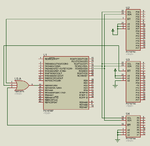thannara123
Advanced Member level 5

Hello I want to check 80 inputs from optocouplers . How can I multiplex input to microcontroler .which is the easy and cheapst way . is it better shift registers ?
can i get any examples . I prefer (8051 ,pic 16f877a, atmega series )
thank you
can i get any examples . I prefer (8051 ,pic 16f877a, atmega series )
thank you









